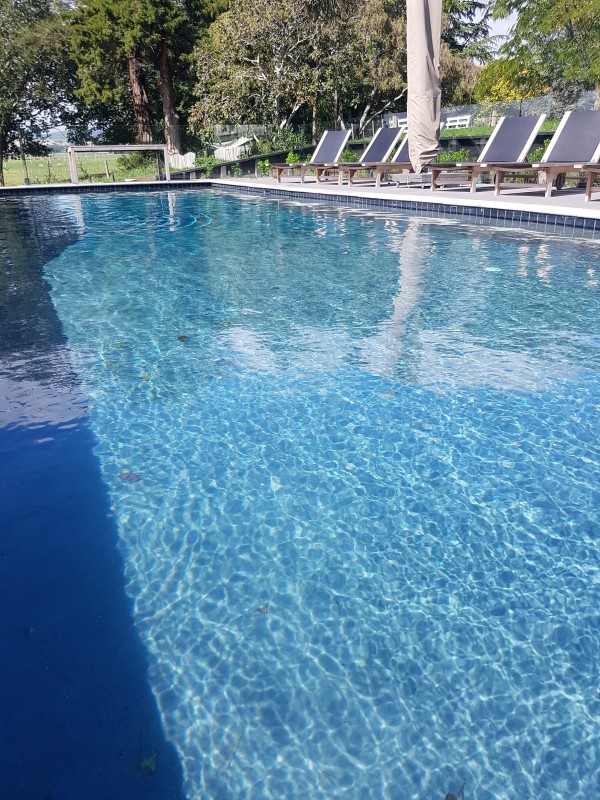What is a Concrete or Shotcrete Pool?
September 15, 2017 at 3:06 PM
Some pool building companies will give you negative information about concrete swimming pools, this is always because they either:
1. Don’t understand them or
2. Can’t build them.
Here at NZ Pools, we love both concrete and fibreglass pools. Usually one will suit a client better and it’s our job to help our client find the pool that is perfect for their situation.
Whilst we love our stunning range of fibreglass Leisure Pools, working with clients to create one of our unique & individualised concrete pools is something we always look forward to. All our pools are engineered by pool design engineers.
As you research information about your potential new backyard swimming pool, you will often encounter the term concrete and shotcrete. You will also hear conflicting information depending on who you are talking to and what their agenda is.
Here are some facts about these strong, versatile and stunning pools.
Concrete shotcrete are formed using pneumatically applied concrete, meaning they are sprayed on with a high-pressure air hose. Crews shoot the material over a reinforcing network of steel bars.
Concrete pools provide unparalleled levels of design flexibility and aesthetic quality. We can look at some basics about this material, how it’s used in pool construction and the great advantages that this type of pool can deliver.
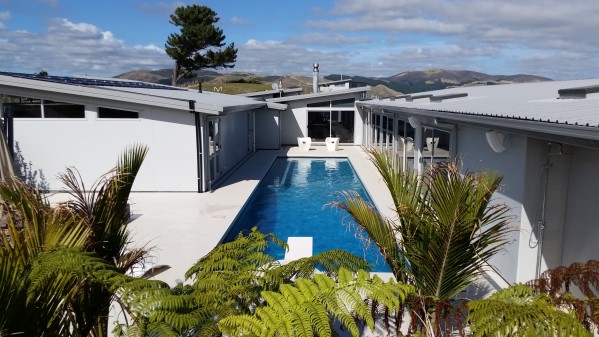
Three key elements unique to shotcrete pool construction
Known for its dependable structural strength, shotcrete is a concrete blend of sand, cement, and water that’s applied through a high-pressure hose. Once it cures (dries), it becomes rock hard, forming a thick, solid structure.
For decades, concrete has held a special place in swimming pool construction, where it is always paired with another strong building material—steel, as well as an interior finishing coat of plaster.
After the hole is excavated for a new pool, our team installs a network of steel bars, known as rebar. Carefully placed at specific intervals, these metal rods form a cage-like frame that extends throughout the entire stretch of the future pool, as well as the spa if there is one. Extra steel goes into areas requiring especially high levels of reinforcement, such as a deep end or free-standing raised wall.
The cage is suspended several inches in the air so it does not touch the soil beneath it. This way, plenty of space remains to be filled in by fresh shotcrete material.
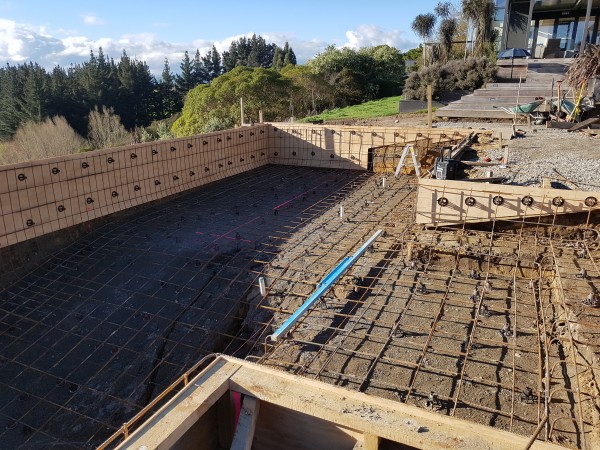
With the steel backbone in place, the pool is ready for the shotcrete. Crews spray the concrete blend at high velocity onto the steel across the entire pool, creating the dense pool floor and walls. This highly adaptable system can produce flowing lines, various contours, depths, and shapes—all coming together in a solid, impressive structure.
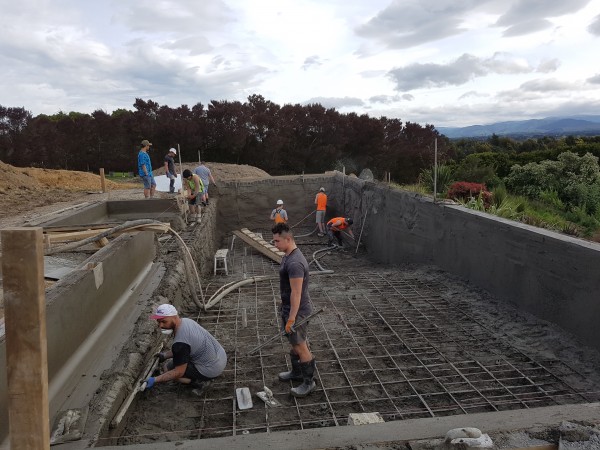
After the concrete properly cures, a third material is applied to complete the pool - plaster. Composed of cement and marble dust, the smooth blend may also contain coloured quartz aggregate for added durability and aesthetics. For some pools, a high-end glass beading may be used. This final coating is what everyone sees as the pool’s sparkling interior surface.
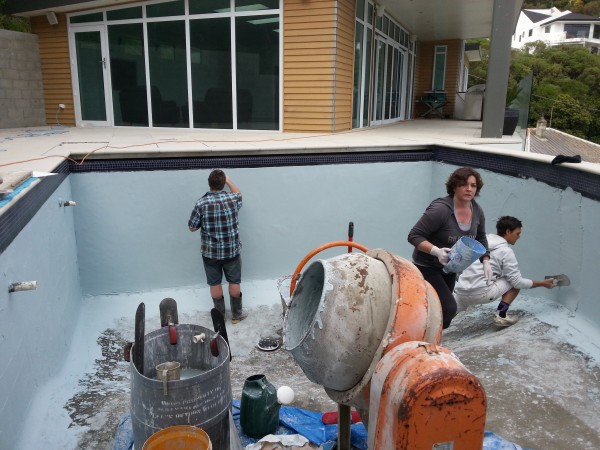
Other elements go into building a concrete pool, including tiling, plumbing, electrics, and perimeter coping. However, what sets this construction apart from other types of pool is the shotcrete, steel, and plaster. And what sets the completed project apart is the incredible durability and design versatility that this trio provides.
Why concrete pools are so popular
Because it’s so versatile for design and durable for longevity, concrete shotcrete pools have long been the standard for both commercial and residential swimming pool construction.
With a concrete pool, options for pool design cross the full spectrum. Whether building pools with smooth curves, sharp angles, or both, concrete delivers. From beach entries to elevated spas, countless design features can be added to boost your pool’s overall style and beauty. You can have a private aquatic resort in virtually any size, shape, depth, and configuration that works best for your budget, backyard, lifestyle, and style preferences.
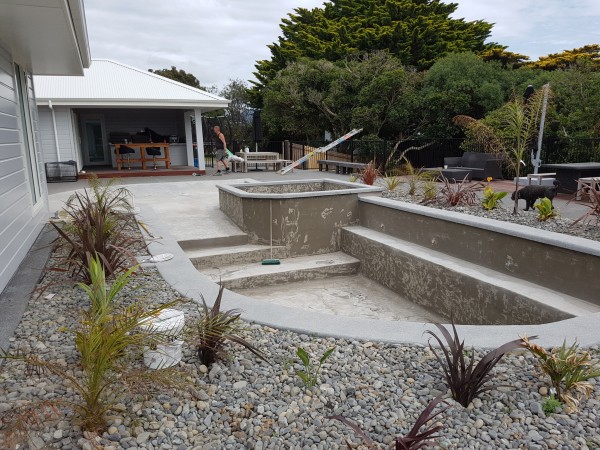
Built to last
Along with distinctive style and ultimate design flexibility, there’s another reason that concrete pools are so widely used for pool construction. Concrete provides an enduring result: a stable, steel-reinforced concrete structure that holds water and stands the test of time.
Concretes proven track record spans decades and in all parts of the country (and globe). The key to its performance lies in its tensile strength—its ability to endure external force until it is compromised.
Along with boasting an extremely high tensile strength, concrete brings something else to the table: flexibility. That’s right, being flexible makes concrete perform even better in a swimming pool.
The reason comes down to the soil—that is, moving ground. Never entirely static, soil under and around a pool moves in place. It contracts and expands from factors like compaction, water intrusion, freezing and thawing, and dry conditions like drought. And of course, soil changes occur from earthquakes—even tiny ones we do not realise ever happened.
The lesson here is that a pool shell needs to “give” and be able to “go with the flow.” The structure—as tough and solid as it is—must have a dual personality so it can move and expand—and do it all without cracking!
It’s this twin-set of attributes that makes concrete a superstar. The concrete shell can handle the pressure that most any backyard can dish out. After all, it’s not a coincidence that in California which is known as earthquake country—hundreds of thousands of homes have pools that are concrete.
The same goes for commercial pools. There’s a reason it’s rare to see any pool besides a concrete one at a hotel or resort. Businesses that own and maintain these properties know what works best and provides the most value. They need facilities that can be used by scores of guests and still hold up their appearance, safety, and durability.
The Takeaway: Concrete pools provide lasting beauty you can count on
With their superb resilience and all-around good looks, concrete pools provide tremendous value. Hopefully now you understand the basics of their construction, their design versatility, and how concrete pools can ensure a lasting upgrade for your home.
To learn more about our pools and how you can get started on one, contact us on 0800 NZPOOLS | 0800 697665 or email: brent@nzpools.co.nz
